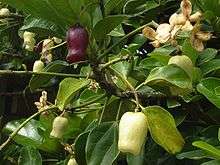Atuna racemosa subsp. racemosa
| Atuna racemosa subsp. racemosa | |
|---|---|
 | |
| Scientific classification | |
| Kingdom: | Plantae |
| (unranked): | Angiosperms |
| (unranked): | Eudicots |
| (unranked): | Rosids |
| Order: | Malpighiales |
| Family: | Chrysobalanaceae |
| Genus: | Atuna |
| Species: | A. racemosa |
| Subspecies: | A. r. subsp. racemosa |
| Trinomial name | |
| Atuna racemosa subsp. racemosa Raf.[1] | |
| Synonyms | |
| |
Atuna racemosa subsp. racemosa is a subspecies of Atuna racemosa, a plant species in the Chrysobalanaceae family.
It is a tree of moderate size, endemic to the Indo-Malaysian and South Pacific areas. It is found growing in such places as Papua New Guinea (kusta), Java, Borneo, Truk Islands (ais) and prolifically on the sea front and in the river valleys of Fiji (makita). This tree once provided the timber for the spars of canoes. The ovoid fruit which this tree bears have been used for medicinal purposes (Truk Is.), or as a glue and varnish in food bowl manufacture (Solomon Is.).[3] Its seeds are a major source of alpha-Parinaric acid, a conjugated polyunsaturated fatty acid with various uses.[4]
References
- ↑ "Atuna racemosa". Tropicos.org. Missouri Botanical Garden. Retrieved 17 January 2014.
- ↑ "Atuna racemosa". World Checklist of Selected Plant Families. Royal Botanic Gardens, Kew. Retrieved 17 January 2014.
- ↑ "Makita A new Crop for Fiji?". Journal of Pacific Studies. University of the South Pacific. Retrieved 17 January 2014.
- ↑ Hilditch, T. P. (1947). The Chemical Constitution of Natural Fats, Second Edition. p. 170. Retrieved 17 January 2014.
This article is issued from Wikipedia - version of the 8/19/2016. The text is available under the Creative Commons Attribution/Share Alike but additional terms may apply for the media files.